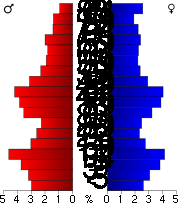
Winnebago County, Iowa
Encyclopedia
2010 census
The 2010 census recorded a population of 10,866 in the county, with a population density of . There were 5,194 housing units, of which 4,597 were occupied.2000 census

Census
A census is the procedure of systematically acquiring and recording information about the members of a given population. It is a regularly occurring and official count of a particular population. The term is used mostly in connection with national population and housing censuses; other common...
of 2000, there were 11,723 people, 4,749 households, and 3,181 families residing in the county. The population density
Population density
Population density is a measurement of population per unit area or unit volume. It is frequently applied to living organisms, and particularly to humans...
was 29 people per square mile (11/km²). There were 5,065 housing units at an average density of 13 per square mile (5/km²). The racial makeup of the county was 97.37% White
Race (United States Census)
Race and ethnicity in the United States Census, as defined by the Federal Office of Management and Budget and the United States Census Bureau, are self-identification data items in which residents choose the race or races with which they most closely identify, and indicate whether or not they are...
, 0.18% Black
Race (United States Census)
Race and ethnicity in the United States Census, as defined by the Federal Office of Management and Budget and the United States Census Bureau, are self-identification data items in which residents choose the race or races with which they most closely identify, and indicate whether or not they are...
or African American
Race (United States Census)
Race and ethnicity in the United States Census, as defined by the Federal Office of Management and Budget and the United States Census Bureau, are self-identification data items in which residents choose the race or races with which they most closely identify, and indicate whether or not they are...
, 0.23% Native American
Race (United States Census)
Race and ethnicity in the United States Census, as defined by the Federal Office of Management and Budget and the United States Census Bureau, are self-identification data items in which residents choose the race or races with which they most closely identify, and indicate whether or not they are...
, 0.72% Asian
Race (United States Census)
Race and ethnicity in the United States Census, as defined by the Federal Office of Management and Budget and the United States Census Bureau, are self-identification data items in which residents choose the race or races with which they most closely identify, and indicate whether or not they are...
, 0.01% Pacific Islander
Race (United States Census)
Race and ethnicity in the United States Census, as defined by the Federal Office of Management and Budget and the United States Census Bureau, are self-identification data items in which residents choose the race or races with which they most closely identify, and indicate whether or not they are...
, 1.01% from other races
Race (United States Census)
Race and ethnicity in the United States Census, as defined by the Federal Office of Management and Budget and the United States Census Bureau, are self-identification data items in which residents choose the race or races with which they most closely identify, and indicate whether or not they are...
, and 0.49% from two or more races. 2.02% of the population were Hispanic
Race (United States Census)
Race and ethnicity in the United States Census, as defined by the Federal Office of Management and Budget and the United States Census Bureau, are self-identification data items in which residents choose the race or races with which they most closely identify, and indicate whether or not they are...
or Latino
Race (United States Census)
Race and ethnicity in the United States Census, as defined by the Federal Office of Management and Budget and the United States Census Bureau, are self-identification data items in which residents choose the race or races with which they most closely identify, and indicate whether or not they are...
of any race.
There were 4,749 households out of which 30.60% had children under the age of 18 living with them, 56.90% were married couples
Marriage
Marriage is a social union or legal contract between people that creates kinship. It is an institution in which interpersonal relationships, usually intimate and sexual, are acknowledged in a variety of ways, depending on the culture or subculture in which it is found...
living together, 7.20% had a female householder with no husband present, and 33.00% were non-families. 29.40% of all households were made up of individuals and 14.70% had someone living alone who was 65 years of age or older. The average household size was 2.36 and the average family size was 2.91.
In the county the population was spread out with 24.10% under the age of 18, 9.80% from 18 to 24, 24.10% from 25 to 44, 23.10% from 45 to 64, and 18.90% who were 65 years of age or older. The median age was 40 years. For every 100 females there were 95.50 males. For every 100 females age 18 and over, there were 92.90 males.
The median income for a household in the county was $38,381, and the median income for a family was $47,306. Males had a median income of $30,720 versus $22,509 for females. The per capita income
Per capita income
Per capita income or income per person is a measure of mean income within an economic aggregate, such as a country or city. It is calculated by taking a measure of all sources of income in the aggregate and dividing it by the total population...
for the county was $18,494. About 5.00% of families and 8.40% of the population were below the poverty line, including 11.90% of those under age 18 and 8.20% of those age 65 or over.
Cities and towns
|
|
|
|
See also
- National Register of Historic Places listings in Winnebago County, Iowa

